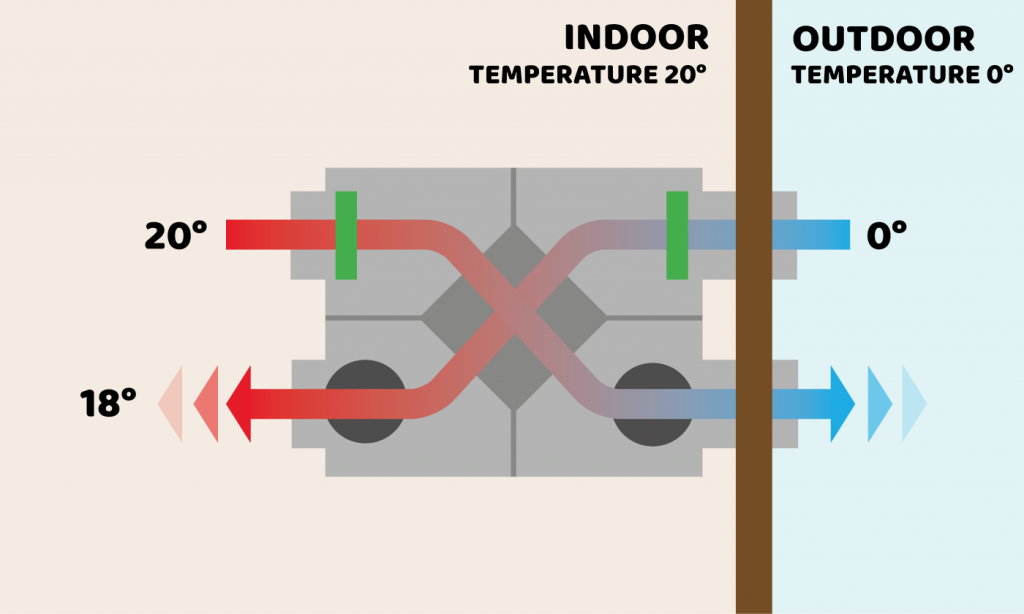The All-Inclusive Overview to the Uses of Heat Recovery Ventilation in Modern Buildings
Heat Recovery Ventilation (HRV) systems stand for a considerable innovation in developing innovation (HRV Heat Recovery Ventilation). They give a method for trading stale indoor air with fresh outside air while reducing energy loss. This method not just boosts interior air quality but additionally adds to energy efficiency in both household and commercial structures. Understanding the different applications and advantages of HRV can expose its critical duty in contemporary layout and sustainability efforts. The ramifications of this modern technology are worth discovering further
Comprehending Heat Recovery Ventilation Equipments

Although lots of modern structures focus on power efficiency, comprehending warmth recovery ventilation (HRV) systems is crucial for maximizing interior air high quality and reducing power intake. HRV systems function by transferring heat from stale indoor air to incoming fresh air, efficiently preserving comfy indoor temperature levels while lessening power loss. These systems consist of a warm exchanger, fans, and ductwork that assist in the blood circulation of air. Throughout winter months, HRV systems catch and recycle warm from the outgoing air, while in summer season, they can aid cool down incoming air. By continually exchanging air, HRV systems likewise decrease humidity and the concentration of indoor contaminants. Correct installation and maintenance of HRV systems are important for their efficiency and performance in boosting total structure performance and comfort.
Advantages of Heat Recovery Ventilation
Heat recovery ventilation systems supply numerous benefits that boost both power performance and interior air high quality in contemporary buildings. By capturing and reusing power from exhaust air, these systems considerably decrease heating and cooling expenses, leading to reduced energy usage. Moreover, they maintain a stable circulation of fresh exterior air, minimizing the risk of interior air toxins and allergens. This constant exchange aids control humidity degrees, preventing mold growth and guaranteeing a much healthier living setting. Furthermore, HRV systems contribute to sustainability objectives by decreasing general carbon impacts. Their capability to maximize ventilation without giving up thermal convenience makes them a beneficial enhancement to contemporary building style, promoting both financial and ecological benefits.
Applications of HRV in Residential Structures
As homeowners significantly focus on energy effectiveness and interior air quality, the applications of warm recuperation ventilation (HRV) systems in property structures have come to be a lot more widespread. HRV systems are particularly helpful in snugly sealed homes, where preserving fresh Going Here air flow is essential for avoiding wetness build-up and indoor pollutants. They successfully transfer heat from outward bound stagnant air to inbound fresh air, minimizing power prices related to cooling and heating. Furthermore, HRVs can improve convenience degrees by managing moisture and temperature level. They are likewise versatile for different domestic styles, consisting of single-family homes and multi-unit structures. Generally, incorporating HRV systems sustains sustainable living practices while guaranteeing a healthier interior atmosphere for owners.
HRV in Business and Commercial Setups
In commercial and industrial setups, the implementation of warm healing ventilation (HRV) systems has ended up being significantly crucial for optimizing energy efficiency and keeping air high quality. These systems successfully transfer warmth from exhaust air to inbound fresh air, reducing the requirement for additional home heating or cooling. This not just lowers energy expenses yet also adds to sustainability efforts. Industries such as production, warehousing, and office complex profit significantly from HRV systems, as they assist manage temperature level and moisture levels, guaranteeing a comfortable and effective atmosphere. HRV systems aid in getting rid of impurities and excess wetness, enhancing indoor air top quality. As laws around air high quality end up being stricter, the fostering of HRV technology is most likely to grow, making it a critical element of modern business and commercial framework.
Future Patterns in Heat Recovery Ventilation Innovation

Frequently Asked Inquiries
Exactly How Does Heat Recovery Ventilation Influence Indoor Air High Quality?
Heat recovery ventilation greatly improves indoor air high quality by continually trading stagnant interior air click over here with fresh outdoor air while recovering power. This process minimizes toxins, keeps ideal humidity levels, and guarantees a much healthier atmosphere for owners.
Can HRV Equipments Be Installed in Existing Structures?
HRV systems can without a doubt be installed in existing buildings. Retrofitting may require alterations to ductwork and ventilation designs, yet it considerably improves power effectiveness and indoor air quality, making it a viable alternative for older frameworks.
What Upkeep Is Required for HRV Systems?

Exist Particular Climates Where HRV Is More Efficient?
Heat recovery ventilation systems are especially efficient in climates with considerable temperature level differences in you can try here between seasons. These systems optimize energy effectiveness by recouping heat from exhaust air, making them perfect for both chilly and moderately warm settings.
How Do HRV Solutions Affect Energy Costs?
